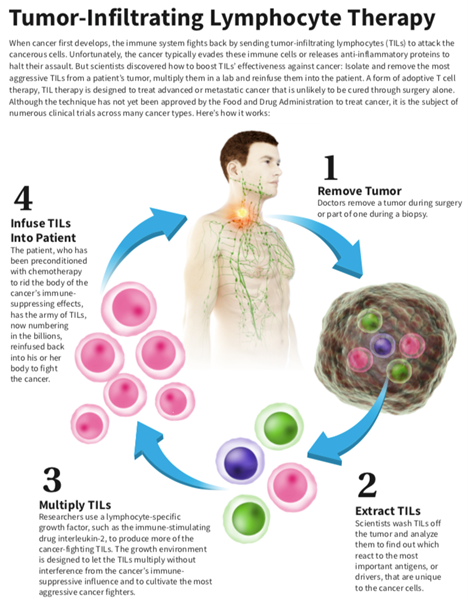Article
Investigational Tumor-Infiltrating Lymphocyte Therapy in Solid Tumors
Investigational Tumor-Infiltrating Lymphocyte Therapy in Solid Tumors
What are naturally occurring (known as endogenous) tumor-infiltrating lymphocytes (TILs)?
In the early stages of cancer, the immune system tries to fight cancer by moving special immune cells, known as lymphocytes (white blood cells), from the blood into a tumor to attack the abnormal lesion. Lymphocytes, a part of the immune system, help the body fight diseases, including cancer.1
TILs are an example of lymphocytes that can recognize and attack the tumor to kill cancer (malignant) cells.TILs are part of the body’s natural response to cancer. They are naturally occurring immune cells that work to find, recognize, attack and kill cancer cells.2 TILs find and recognize cancer through tumor markers that are present on the surface of cancer cells. These tumor markers are diverse and unique to each person. TILs may be able to recognize a wide range of patient-specific tumor markers that are present on the surface of cancer cells. These tumor markers are potential targets for new therapies.3
However, cancer cells have methods to escape the immune system’s attack and avoid destruction.1 Cancer can prevail when it changes the normal cells around the tumor to evade the body’s natural immune response to cancer cells.1,4 Malignant cells may have proteins on their surface that turn off immune cells or they may have genetic changes (mutations) that make them less visible to the immune system.1
When cancer invades and grows, the TILs are unable to perform their intended function. Malignant cells can evade detection by TILs or exhaust the TILs to render them ineffective. There may not be enough TILs to kill the tumor or to overcome the tumor’s ability to send signals to suppress the immune system. Therefore, the tumor-killing effect of the natural TIL is usually short-lived.3
What are the types of immunotherapy and T-cell transfer therapy?
Immunotherapy is intended to help the immune system fight cancer. T-cell transfer therapy (also known as adoptive cell therapy, adoptive immunotherapy and immune cell therapy) is a type of immunotherapy that boosts the natural ability of your T-cells to fight cancer by allowing them to recognize and attack cancer cells.1 Several types of immunotherapies are used to treat cancer, and others are being investigated in clinical trials.1
One way that cancer cells can evade the immune system is through genetic mutations that increase the number of certain types of proteins, known as immune checkpoints, that switch off immune cells. Immune checkpoint inhibitors are a type of drug that blocks these immune system checkpoints that stop T cells from attacking cancer cells. This allows the body to have a stronger immune response and makes cancer cells more susceptible to attack by the T cells.1
T-cell transfer immunotherapy uses the patient’s own cells to fight the malignancy. After immune cells are collected from the patient, they are genetically modified (in some therapies), expanded in number and returned to the patient, where they can attack cancer cells.1 Some T-cell transfer therapies are approved by the FDA, whereas others are being investigated in clinical trials. Chimeric antigen receptor (CAR) T-cell therapy and TIL cell therapy are the two main types of T-cell transfer therapy.2
What are CAR T-cell therapy and TIL cell therapy?
CAR T-cell therapy is a type of cell therapy that is currently approved to treat cancers of the blood, called hematological cancers.2 In CAR T-cell therapy, a patient’s T cells are taken from the blood and changed in a laboratory to create CAR, a specific type of protein. Modified T-cells used in CAR T-cell therapy are designed to detect a single (1) specific protein. A large number of these modified T cells are grown in the laboratory and then returned to the patient’s body by intravenous (IV) infusion. This additional protein allows T cells to attach to a specific protein on the surface of cancer cells, which improves the ability of T cells to attack and destroy cancer cells.2 This is an option for patients with blood cancers, which typically have a single protein to target. However, for solid tumors, targeting a single (1) tumor marker is not enough. These solid tumor markers are diverse and unique to each person; in fact, fewer than 1% of these tumor markers are the same among different patients. Therefore, a therapeutic approach is needed that allows for multi-protein targeting, or the ability to recognize a multitude of patient-specific tumor proteins.
TIL cell therapy is another type of cell therapy that is currently being investigated as a treatment for solid malignant tumors. TIL therapy may be able to find and recognize a wide range of patient-specific tumor protein markers that are present on the surface of solid tumor cancer cells. Unlike CAR T-cell therapy, where T-cells are obtained from blood plasma and modified, TIL cell therapy generates cancer-fighting cells by using a patient’s own naturally occurring TILs taken directly from the patient’s own tumor. TILs include T-cells that can exhibit a variety of different solid tumor cell surface proteins, enabling them to recognize and react to multiple types of tumor proteins simultaneously.5,6 TILs are then tested to determine the ones that can best recognize the patient’s tumor cells. TILs are then grown in large numbers in a laboratory and given back to the patient to help the immune system kill the cancer cells.2 These TILs are then multiplied and readministered to the patient by an IV infusion. This is different from CAR T-cell therapy. There currently are no FDA-approved TIL cell therapies; their safety and efficacy are being determined in clinical trials.2
Why might investigational TIL therapy be an option for solid tumors?
TIL therapy is unlike other cell therapies.2 CAR T-cell therapy is designed to recognize a specific protein found on cancer cells before being returned to the patient, where they can then attack the cancer. Because TILs are taken directly from a patient’s tumor, they may recognize many of the unique targets specifically expressed on the surface of their tumor cells. The idea behind this approach is that the TILs that are in or near a specific tumor already can recognize and mount a response to unique proteins expressed by these tumor cells.2 They don’t have to be modified to recognize the tumor. This is a key advantage, because cancer cells often can evade the immune system by effectively “hiding” from one target at a time.7 The ability of TILs to recognize and respond to multiple tumor proteins decreases the likelihood of tumor cells evading the immune response by altering the expression of a single tumor-specific protein.6 Often, too few TILs may be present to kill the tumor cells or to overcome the signals that the tumor releases to suppress the immune system.
Expanding the population of TILs allows large numbers of the cancer-fighting cells to recognize and attack that patient’s specific tumor.2 Doctors test these lymphocytes in the laboratory to identify the ones that best recognize the patient’s tumor cells. These selected TILs then are treated with substances that make them reproduce and grow in number quickly.2 Another potential advantage of TIL therapy is that it may be long-lasting; in some cases, the TILs continue to patrol the patient’s body for several years after a single infusion.8
What can we learn from the patient experience with TIL therapy being studied in clinical trials?
Currently, TIL therapies are only available through clinical trials. TIL cell therapy is personalized for each patient, meaning that all patients receive a unique TIL therapy made from their own tumor cells.
Unlike many other forms of cancer treatment that require ongoing care, TIL cell therapy is given once.9 TIL therapy and immune checkpoint inhibitors can work to target and attack cancer cells as they break down barriers to enable the immune system to mount a response. With combination therapy, patients first receive an immune checkpoint inhibitor followed by TIL therapy as a one-time treatment; they later receive maintenance treatment with an immune checkpoint inhibitor.
The overall patient experience with investigational TIL therapy is described below:
- TILs, the immune cells that have penetrated the tumor, are collected during a biopsy or surgery involving removal of one or more tumors removed from the patient.8
- In the laboratory, the TILs are treated with interleukin-2 (IL-2), a protein that causes the cells to rapidly reproduce, resulting in a large number of TILs.This process typically takes several weeks, which means that patients will qualify for TIL therapy only if their tumor is stable enough to withstand that waiting period.8
- Before the TILS are returned to the patient’s body, the patient must have a short course of chemotherapy to make room for the new immune cells and help the TILs attack the tumor.8
- After successfully grown to billions in number, the TILs are then given back to the patient via IV infusion. They then actively attack and destroy cancer cells as they leave healthy cells alone.8
Are there expected side effects to TIL therapy?
Patients stay in the hospital for at least a few days so that doctors can monitor them for any side effects or reactions to therapy. The side effects that develop shortly after the TIL infusion usually are relatively minor—especially when compared with side effects associated with many other cancer treatments. They may include fever, chills and shortness of breath. Two weeks after the TIL infusion, the chance of a new side effect occurring is low, perhaps because TIL therapy typically is performed only once rather than on an ongoing basis.8
After receiving an infusion of TILs, patients will also be given a drug, such as IL-2, to help stimulate TIL activity in the body. Although most patients do not experience major side effects with TIL therapy, treatment with IL-2 can lead to some side effects that can be managed. TIL therapies that use IL-2 currently are being studied to reduce possible overall side effects.
What clinical trial opportunities are available for investigational TIL therapy?
Treatment with TIL cells given alone and as part of combination therapy with immune checkpoint inhibitors is being investigated in patients with various types of solid tumors in clinical trials. An overview of the clinical trials that are supported by the National Cancer Institute and that are recruiting patients with different types of cancer (e.g. multiple advanced solid tumors like melanoma, non–small cell lung cancer [NSCLC] and cervical cancer) are available at this website: Clinical Trials Involving TIL Therapy.
Where can I find more information about TIL therapy?
Watch the CURE® Educated Patient® Webinar, “Deep Dive into TIL Cell Therapy for Those Living with Cancer,” available here.
Another CURE® video series with Adam J. Schoenfeld, MD, highlights the potential for TIL therapy, which depends on results from ongoing clinical trials in NSCLC after first-line treatment. It can be viewed here.
For more information on how TIL therapy works, the Melanoma Research Foundation has an animated video that explains investigational TIL cell therapy for patients with melanoma.
Additional resources are available from:
- TIL Working Group
- The American Melanoma Foundation
- Foundation for Women’s Cancer
- Lung Cancer Research Foundation
For a summary of how investigational TIL therapy works, see the infographic below.10

Figure reprinted with permission from Paturel A. CUREToday.com. Published June 30, 2020. Accessed September 9, 2022. https://www.curetoday.com/view/unleashing-the-power-within-using-tumorinfiltrating-lymphocyte-therapy
References
1. Immunotherapy to treat cancer. National Cancer Institute. Updated September 24, 2019. Accessed August 27, 2022. https://www.cancer.gov/about-cancer/treatment/types/immunotherapy
2. T-cell transfer therapy. National Cancer Institute. Updated April 1, 2022. Accessed August 27, 2022. https://www.cancer.gov/about-cancer/treatment/types/immunotherapy/t-cell-transfer-therapy
3. de Lartigue J. TILs, the ultimate in personalized immunotherapy, move closer to market. OncLive®. 2020;21(22):61-64. November 24, 2020. Accessed August 27, 2022. https://www.onclive.com/view/tils-the-ultimate-in-personalized-immunotherapy-move-closer-to-market
4. Nowicki TS, Hu-Lieskovan S, Ribas A. Mechanisms of resistance to PD-1 and PD-L1 blockade. Cancer J. 2018;24(1):47-53. doi:10.1097/PPO.0000000000000303
5. Rohaan MW, Wilgenhof S, Haanen JBAG. Adoptive cellular therapies: the current landscape. Virchows Arch. 2019;474(4):449-461. doi:10.1007/s00428-018-2484-0
6. Rosenberg SA, Restifo NP. Adoptive cell transfer as personalized immunotherapy for human cancer. Science. 2015;348(6230):62-68. doi:10.1126/science.aaa4967
7. What are TILs and why are they important? Breast Cancer Research Foundation/ International Immuno-Oncology Working Group on Breast Cancer. Accessed August 27, 2022. https://www.tilsinbreastcancer.org/what-are-tils/
8. TIL therapy. Moffit Cancer Center. 2018. Accessed August 27, 2022. https://moffitt.org/treatments/immunotherapy/cellular-immunotherapy/til-therapy/
9. Boldt C. TIL therapy: 6 things to know. The University of Texas MD Anderson Cancer Center. April 15, 2021. Accessed August 27, 2022. https://www.mdanderson.org/cancerwise/what-is-tumor-infiltrating-lymphocyte-til-therapy--6-things-to-know.h00-159460056.html
10. Paturel A. Unleashing the power within using tumor-infiltrating lymphocyte therapy. CUREToday.com. Published June 30, 2020. Accessed September 9, 2022. https://www.curetoday.com/view/unleashing-the-power-within-using-tumorinfiltrating-lymphocyte-therapy


